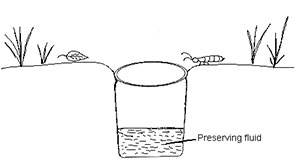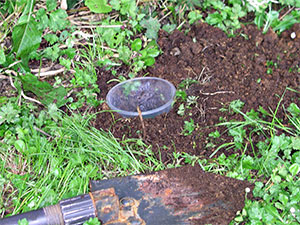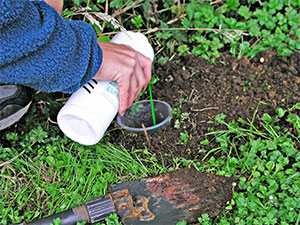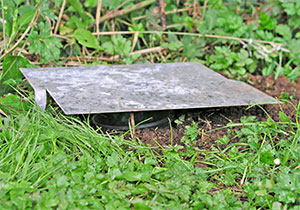|
|
|
Pitfall trap
Pitfall traps are used to capture invertebrates that travel about on the soil surface (epigaeic). The simplest pitfall trap can be made from a glass jar or a plastic food container. To install a pitfall trap, dig a hole in the ground, and place the container into the hole so that the rim of the container is level with the ground surface. Carefully fill the gap around the container with soil, creating a level surface. A small amount of preserving fluid is added to the container to kill and preserve any animal that falls in - for that purpose, ethylene glycol (car antifreeze) can be used. Keep in mind, however, that ethylene glycol is toxic for people, and often lethal for cats and dogs, so propylene glycol or alcohol are safer options. A cover of some sort needs to be propped over the trap to keep the rain out if the trap is left unattended for long time, as the rainwater will dilute the preserving fluid, and may even fill the trap altogether.
|

Pitfall trap.
|
 Installation of a pitfall trap, Step 1: plastic container is placed level with the ground surface. |
 Installation of a pitfall trap, Step 2: preserving fluid is added. |
|
The pitfall trap can be checked at various intervals, from every few days to once every few weeks. If the pitfall trap is left out for too long, the captured invertebrates may begin to decompose, which often results in large numbers of carrion beetles attracted by the smell falling into the trap. Caution should be applied if you plan to use pitfall traps in the areas of New Zealand where native lizards are found, as they often fall into the traps and die there.
Pitfall traps are used extensively for sampling ground-dwelling invertebrates. However, pitfall trap catches give a biased representation of invertebrate communities, because actively moving species are always captured in larger numbers than slow-moving ones. For example, if a pitfall trap is set up in a New Zealand native forest, the large surface-dwelling Collembola, landhoppers (Amphipoda), ground beetles (Carabidae), spiders and mites will make up most of the catch, with many other groups underrepresented. Another "pitfall" of the pitfall traps is the propensity of curious trampers to pulling them out.
|

The cover protects the trap from the rain.
|
|
|